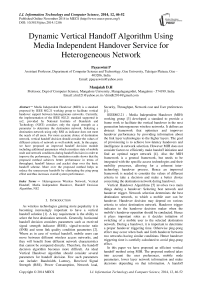Dynamic Vertical Handoff Algorithm Using Media Independent Handover Service for Heterogeneous Network
Автор: Payaswini P, Manjaiah D.H
Журнал: International Journal of Information Technology and Computer Science(IJITCS) @ijitcs
Статья в выпуске: 12 Vol. 6, 2014 года.
Бесплатный доступ
Media Independent Handover (MIH) is a standard proposed by IEEE 802.21 working group to facilitate vertical handover support between heterogeneous networks. Currently, the implementation of the IEEE 802.21 standard supported in ns2, provided by National Institute of Standards and Technology (NIST) considers only the signal strength as a parameter to determine the destination network. Selecting a destination network using only RSS as indicator does not meet the needs of all users. For more accurate choice of destination network, vertical handoff decision should consider the values of different criteria of network as well mobile node. In this paper, we have proposed an improved handoff decision module including additional parameters which considers state of mobile node and network conditions during handoff decision in order to improve the performance. The simulation results shows that the proposed method achieves better performance in terms of throughput, handoff latency and packet drop over the basic handoff scheme. More over the proposed method helps to reduce the unnecessary handoffs by eliminating the ping-pong effect and thus increases overall system performance.
Heterogeneous Wireless Network, Vertical Handoff, Media Independent Handover, Handoff Decision Algorithm, NS2
Короткий адрес: https://sciup.org/15012204
IDR: 15012204
Текст научной статьи Dynamic Vertical Handoff Algorithm Using Media Independent Handover Service for Heterogeneous Network
Published Online November 2014 in MECS DOI: 10.5815/ijitcs.2014.12.06
As wireless technologies gaining more popularity it is becoming increasingly important to have a vertical handoff solution [1]. A key requirement is the ability to select the best destination network. Generally, horizontal handoff decision considers parameters such as received signal strength indicator (RSSI), signal-to-noise ratio (SNR) and some link quality condition parameters [2]. Where as in case of vertical handoff, mobile users can move between different wireless access networks, and they will benefit from different network characteristics that cannot be compared directly. Therefore, the handoff decision algorithm becomes more difficult. An ideal Vertical Handover algorithm should consider several parameters for handoff decision. Few such parameters can include: Bandwidth, Latency, Received Signal Strength (RSS), Power Consumption, Network load,
Security, Throughput, Network cost and User preferences [1].
IEEE802.21 - Media Independent Handover (MIH) working group [3] developed a standard to provide a frame work to facilitate the vertical handover in the next generation heterogeneous wireless networks. It defines an abstract framework that optimizes and improves handover performance by providing information about the link layer technologies to the higher layers. The goal of provisioning is to achieve low-latency handovers and intelligence in network selection. However MIH does not consider factors to efficiently make handoff initiation and find an optimal target network [4]. Also the MIH framework is a general framework, but needs to be integrated with the specific access technologies and their mobility processes, allowing for a coherent intertechnology handover process. Hence an improved framework is needed to consider the values of different criteria to take a decision and make a better choice concerning the destination network during handover.
Vertical Handover Algorithms [5] involves two main things during a handover: Selecting best network and handover trigger. Network selection determines the best destination network, to which a mobile user can be handover. Handover decision may depend on various criteria to select destination network. Handover trigger indicates to the handover decision maker when the mobile’s handover operation should be conducted. Hence it plays important roles as it decides initiation of switching of a mobile user to the selected destination network. During a handover, it is important to determine a proper handover triggering time. Otherwise ping-pong effect may occur when back and forth handover between two networks having similar conditions. Hence handover triggering time is carefully calculated to avoid ping-pong effect.
In this paper we have proposed an efficient vertical handoff method using MIH. The proposed method takes into account the user preferences, mobile node parameters, lower layer network information and make decisions depending on that information. A handoff initiation method, which is proposed in this module, considerably reduces unnecessary handoffs and helps to increase overall system performance.
The remainder of this paper is organized as follows: Section II describes the related work. Section III describes proposed method. Section IV gives overview of simulation of proposed method using NS2 simulator. Section V describes the simulation results and we conclude in Section VI.
-
II. Related Work
Various vertical handoff decision algorithms have been proposed recently. Due to the relevance of mobility interoperability in future networks, a significant amount of related work has been published by the academic community as well. In [1] a detailed survey on existing vertical handoff algorithm, their classification and comparison is given. A detailed introduction to MIH standard is given in [6][7]. In [8] authors provided a framework for the implementation of the MIH standard and evaluated its performance in integrated 802.11/802.16e networks through simulation. A mathematical model for analyzing the performance of MIH signaling is proposed in [9]. IEEE 802.21 based vertical handover schemes are proposed in [10] and [11]. Unfortunately, the proposals lack interaction between the MIH framework and the access technologies, QoS specificities. Furthermore, performance measurements are also not given [12] and standard should be extended to further facilitate seamless handover provision.
Deciding best target network is another important challenge in vertical handoff. From the literature it is found that Multi Attribute Decision Making (MADM) methods are widely used in handover decisions. Performance comparison among Simple Additive Weighting, Technique for Order of Preference by Similarity to Ideal Solution (TOPSIS), Grey Relational Analysis (GRA), and the Multiplicative Exponent Weighting (MEW) for vertical handoff decision is given in [13]. A context aware vertical handoff algorithm that considers both users and services requirements is proposed in [14]. A network selection algorithm based on Fuzzy Multiple Attribute Decision Making is proposed in [15]. The Network selection function is used to measure the efficiency in utilizing radio resources. Each network associated with parameters Received Signal Strength (RSS), Monetary cost(C), Band Width (BW), Velocity (V) and user preference (P). Even though there are a lot of vertical handoff algorithms in literature, these vertical handoff algorithms either lack in comprehensive consideration of various network parameters or the detailed implementation information.
-
III. Proposed Work
For efficient vertical handoff algorithm, many network characteristics need to be considered for handoff decision. These include cost of service, security, power consumption, network conditions, and network performance. In this proposed work, the vertical handoff decision algorithm considers the following aspects [16]: • The state of the wireless access networks: This includes the available RSS, bandwidth, and cost of the service, network coverage.
-
• The state of the Mobile Node: This includes the velocity and Battery level of the MN.
-
• User Preference: This includes ranking of networks according to the user.
-
• The current condition of the system as well as its future possible evolutions.
Considering the above aspects, we propose a vertical handover decision algorithm using MIH. The algorithm includes two modules namely, handoff initiation module and handoff decision module.
Handoff Initiation module: The handoff initiation module plays important role as it helps to reduce unnecessary handoff and thereby enhancing throughput and user satisfaction. It is also called as pre-handoff decision phase. Handoff initiation module consists of two parts namely estimating the necessity of handoff and selecting potential target networks which are capable of providing basic guaranteed service to the user. Handoff necessity estimation phase checks whether there is a need for handoff by using parameters like velocity of the MN, coverage area of the serving network. For example, if MN’s moving with very high speed, WLAN cannot support its speed. In this case handoff to larger coverage area network would be preferable. By considering velocity of MN it is obvious that unnecessary handoff can be eliminated. If there is need for handoff, then the list of candidate networks which are capable of providing basic guaranteed service to the user are sent to handoff decision module. In order to list the potential candidate network, we have used Minimum Guaranteed function as given in (1). Minimum guarantee indicates whether the minimum guarantee of MN is supported for every network i. According to [17] minimum guarantee function Mi for each network i can be given by,
M i = F (B i - B th ) · F (RSS i - RSS th ) · F (V i - V th ).
-
F (T i - T th ) • F (P i — P th ) • F (C i — C th ) ^ (1)
Where B i is Available bandwidth, RSS i is Received Signal Strength (RSS), V i is velocity of MN, T i is duration, P i is battery power level and C i is cost of service for network i. Also the parameters B th , RSS th , V th , T th , P th and C th indicates the pre-defined thresholds of available bandwidth, RSS, velocity, duration, battery power and cost of service for network i. The duration Ti denotes the estimated time MN will stay in a particular network i. By considering velocity of mobile node and coverage of the network, Ti can be predicted along with other parameters like moving pattern of MN, and the location information of MN [17].
The function F(.) is a unit step function which is a discontinuous function whose value is zero for negative argument and one for positive argument. Hence, if there is any negative value in any of the term in (1) then Mi becomes zero. This indicates that for any particular network i, if parameter value is lower than its threshold, the minimum guarantee function has zero value. Now, if Mi value is zero for a particular network i, then that network is not considered as a candidate network and if it is one it is included in the set of candidate networks S. Initially the set S is set to be empty at the beginning of every handoff decision. Hence set S contains candidate networks which are capable of providing minimum guaranteed service to MN and those which are not capable of providing minimum level of service to MN are eliminated from list candidate network. In this way handoff decision time also reduced. The set of candidate network S is then sent to handoff decision module.
Handoff Decision module: During handoff decision phase, the target network is selected from set of candidate network using (2). The vertical handoff decision problem is formulated as objective function Hi. In our proposed algorithm, dynamic weights used so that the objective function is adaptive to different metrics of several networks. The objective function Hi can be given as follows,
Maximize H i (v) ^ (2) v
Where H i ( v ) is the objective function evaluated for the network i and v is the input parameters. The objective function H i can be mathematically expressed as:
Hi = F(RSS i , 1/C i , B i , 1/P i , U i , V i )
Hi = WR i ×RSS i + WC i (1/C i ) + WB i ×B i + WP i (1/P i )
-
+ WU i xU i + WV i xV i ^ (3)
Where RSS i , C i , B i , P i , are normalized values of Received Signal Strength, Cost of service, Bandwidth, Power consumption, and U i and V i are the user preference and velocity of the MN. Normalization is needed to ensure that the sum of the values in different units is meaningful. The dynamic weights can be given by [18]
|
WRi = |
– |
WCi = |
– |
|
|
RSSmax-RSSmtn |
Cmax-Cmm |
|||
|
WBi = |
– |
WPi = |
– |
|
|
Bmax-Bmm |
Pmax-Pmm |
|||
|
WVi = |
– |
WUi = |
Ui . — "> |
(4) |
|
Vmax-Vmm |
||||
|
n |
||||
For each network, H i is consistently calculated and the network having highest value for H i is chosen as the target network. Therefore, this objective function-based model estimates dynamic network conditions and includes a stability period to ensure that a handoff is worthwhile for each mobile. The flowchart of the proposed method is as given in fig.1.
The algorithm is executed whenever there is a Link-up Link down or Link Going Down trigger from MIH. If Link-up trigger occurs and Uplink id is WLAN then wait for small period of time in order to check whether signal strength is increasing or decreasing. This helps to reduce ping-pong effect [19]. Next step of the proposed method is calculating the Mi value for each network i. Let us consider that there are N networks available. In this step, the handoff initiation module evaluates whether the minimum guaranteed service to a user is supported for every network i, Mi, for i = 1, 2,..., N. The set of candidate network contains networks whose Mi value is one. It is obvious that by introducing the duration into the minimum guarantee function, the ping-pong effect can be considerably eliminated. Thus, proposed approach reduces unnecessary handoffs while increasing network throughput, decreasing handoff delay, and avoiding connection dropping. In addition, the velocity is also considered in the first step to eliminate unnecessary handoff.
After the handoff initiation phase, according to the size of the candidate network set S, the propose decision algorithm generally falls into three cases [17]. The first case is that the set S is empty, and in this case MN remains connected to the current network. Secondly, there is only one member in set S. Here there may be further two scenarios. If sole network is the current network, MN stays in the current network; otherwise, MN decides to perform vertical handoff to target network. In the third case there are more than one network have been added into the set S. More specifically, there is more than one network, whose minimum guarantee function value is one. In this case MN uses objective function as given in (3) to select target network. After selecting the target network the traffic is rerouted from current network to target network.
-
IV. Simulation setup
The simulation is carried out in order to study the performance of the proposed method. For simulation purpose we have used ns2 with NIST’s IEEE 802.21 addon module. It consists of one UMTS, WiMAX base station and two WiFi access points as shown in the fig.2. The simulation is carried out for a period of 600 sec. MN is configured to use interfaces UMTS, WiFi, and WiMAX. Video traffic is created between CN and MultiFace node.
The mobility of a mobile node is fixed according to the path from point A to point B as shown in simulation scenario. Initially, when simulation starts MN connected to UMTS network and continues its communications with CN using UMTS network. As it moves it encounter WiFi Network and MN gets transferred to Wi-Fi and continues communication with CN. MN remains connected to WiFi as long as H i value is high than all other network. Whn H i for WiMAX becomes more than that of WiFi, MN will hand over to WiMAX network.
As soon as the new network becomes available, trigger for signal strength, user presences, Available bandwidth, velocity of MN, battery power level and cost of service for network i are generated to obtain the parameters and are forwarded to handoff initiation module to decide necessity of handoff.
To study the performance of the proposed method MN velocity is varied for different values ranging from 5 m/s to up to 35 m/s. The simulation is repeated number of times and average value is taken to improve the accuracy of the result. The simulation parameters are as given in the following table.
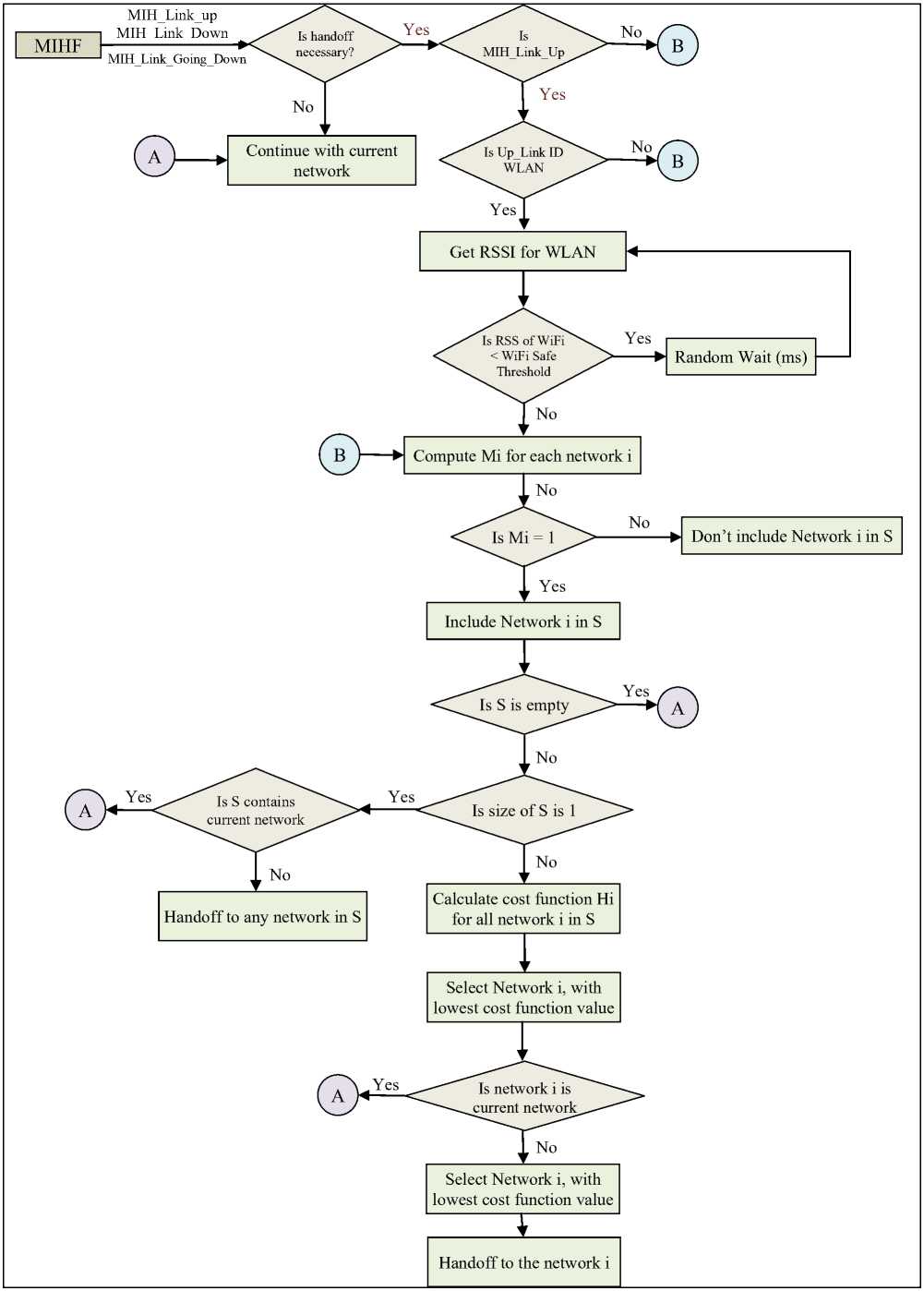
Fig. 1. Flowchart of proposed method
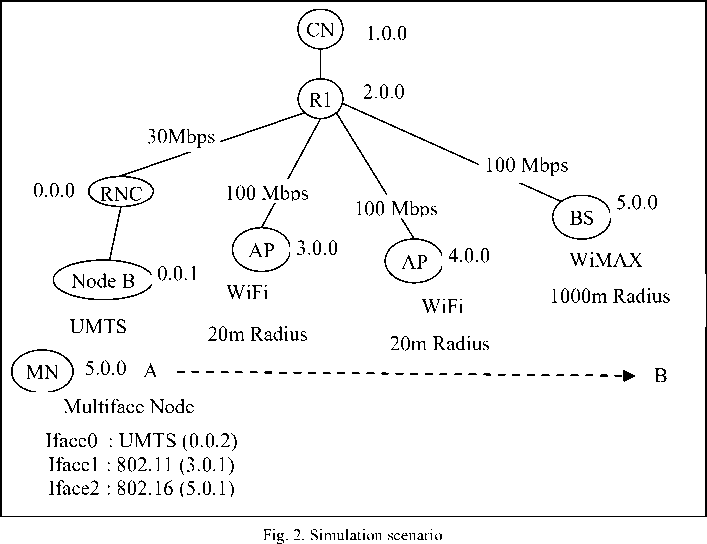
Table 1. Simulation parameter values
|
Parameter |
Value |
|
Wireless Node |
|
|
Propagation model |
TwoRayGround |
|
routing protocol |
DSDV |
|
WiFi Configuration |
|
|
WLAN beacon interval (s) |
0.1 |
|
MinChannelTime (s) |
0.02 |
|
MaxChannelTime (s) |
0.06 |
|
Data rate (Mbps) |
11 |
|
RXThresh |
6.12277e-09 |
|
WiMAX configuration |
|
|
RXThresh |
1.26562e-13 |
|
Radius (m) |
1000 |
|
ucd_interval (s) |
5 |
|
dcd_interval (s) |
5 |
|
modulation |
OFDM_16QAM |
|
Antenna model |
OmniAntenna |
|
UMTS Configuration |
|
|
Transport channel |
Dedicated Channel (DCH) |
|
llType |
UMTS/RLC/AM – acknowledgment mode |
|
DCD interval (s) |
5 |
|
UCD interval (s) |
5 |
|
Modulation |
OFDM_16QAM |
|
uplinkBW |
384kbps |
|
uplinkTTI |
10ms |
|
downlinkBW |
384kbps |
|
downlinkTTI |
10ms |
|
Mobility Model |
|
|
Velocity (m/s) |
5 to 35 |
|
Path |
Straight line |
|
Application Traffic for Mobile Node |
|
|
Type |
UDP video |
|
Packet size (bytes) |
1240 |
-
V. Simulation Results
In this section, we present the simulation results. For scenario shown in fig.2, we have found the values for throughput, handoff latency and packet loss. This analysis of the system performance is needed to ensure that the proposed system is better than basic NIST module. The graph of handoff latency, throughput and packet drop is as shown in the following graph.
Handoff latency: The handoff latency is the amount of time from when the mobile is disconnected from the old base station to when the mobile receives the first packet from the new base station. This is nothing but the time interval between the first Link_Going_Down trigger generation and the HO_Complete generation. The graph of handoff latency versus speed of MN is as shown in the fig.3. The proposed model reduces handoff latency compared to basic NIST model. At lower velocity there is no much considerable difference in handoff latency. But as velocity of MN increases handoff latency also increases but less compared to NIST model.
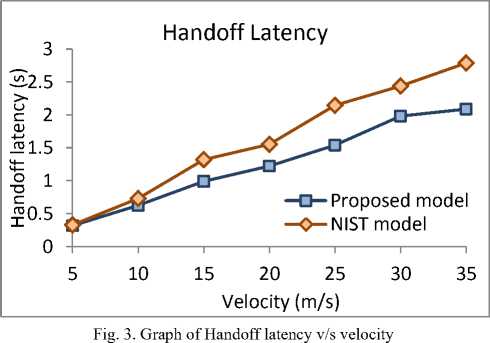
Throughput: The throughput is measured with respect to the speed of the mobile node. Fig.4 shows that the throughput measured has been found to slightly increase as the speed of the mobile node. Moreover proposed model give better throughput when compared to basic NIST module.
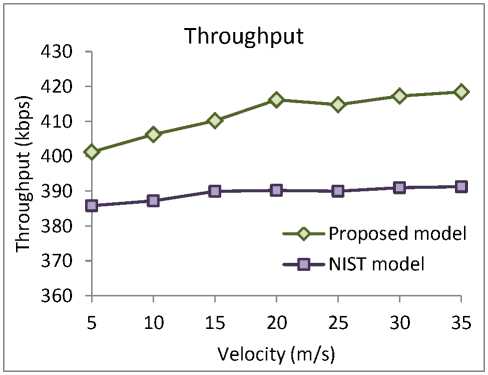
Fig. 4. Graph of Throughput v/s velocity
Packet drop: It is measure of average number of packet drops during the simulation. From fig.5 it is observed that the proposed method reduces packet drop considerably over basic NIST model. Packet loss values are higher in NIST model as shown in fig.5 as compared to the proposed model. Packet loss is almost null in proposed model for lower speeds.
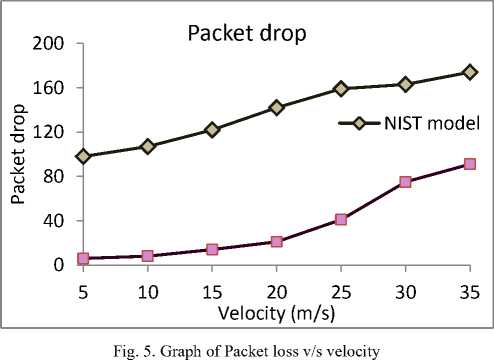
-
VI. Conclusion
Seamless vertical handoff is key requirement for next generation network. Vertical Handoff decision to select destination network based on the Radio Signal Strength only is not always a good strategy. Hence there is a need for a new framework taking into account different parameters to guide network selection process during handover decision. In this paper a vertical handoff model formulated as objective function of multiple parameters with dynamic weights. The proposed model helps to reduce the unnecessary handoffs. The simulation is performed using NS-2 simulator shows that the inclusion of additional parameters significantly improves the overall performance for mobile users. Simulation results demonstrate that proposed approach achieves improvement with respect to throughput, handoff latency and packet drop. Compared with basic NIST module the proposed approach has a slight increase in throughput, and decrease of latency and packet drop.
Acknowledgement
The authors would like to acknowledge the funding support from DST under the scheme of INSPIRE fellowship (Ref.No. DST/INSPIRE Fellowship/2012/[82] dated August 17, 2012). Thanks also go to the dedicated research group in the area of Computer Networking at the Dept of Computer Science, Mangalore University, Mangalore, India, for many stimulation related discussions. The authors also would like to acknowledge the NIST seamless mobility working team for NS2 addon for simulation of MIH standard. Last but not the least the author would like to thank everyone, including the anonymous reviewers.
Список литературы Dynamic Vertical Handoff Algorithm Using Media Independent Handover Service for Heterogeneous Network
- Yan, Xiaohuan, Y. Ahmet Şekercioğlu, and Sathya Narayanan. "A survey of vertical handover decision algorithms in Fourth Generation heterogeneous wireless networks." Computer Networks 54.11 (2010): 1848-1863.
- Çeken, Celal, Serhan Yarkan, and Hüseyin Arslan. "Interference aware vertical handoff decision algorithm for quality of service support in wireless heterogeneous networks." Computer Networks 54.5 (2010): 726-740.
- IEEE Standard for Local and metropolitan area networks - Part 21: Media Independent Handover Services
- Kumar, Vimal, and Neeraj Tyagi. "Media Independent Handover for Seamless Mobility in IEEE 802.11 and UMTS based on IEEE 802.21." Computer Science and Information Technology (ICCSIT), 2010 3rd IEEE International Conference on. Vol. 4. IEEE, 2010.
- Li, Mo. Handover mechanisms in next generation heterogeneous wireless networks. Diss. University of Technology, Sydney, 2008.
- de la Oliva, Antonio, et al. "IEEE 802.21 (Media Independent Handover Services) Overview." Interface 3 (2008): 3GPP2.
- la Oliva, Antonio de, et al. "IEEE 802.21: Media independence beyond handover." Computer Standards & Interfaces 33.6 (2011): 556-564.
- Lim, Wan-Seon, et al. "Implementation and performance study of IEEE 802.21 in integrated IEEE 802.11/802.16 e networks." Computer Communications 32.1 (2009): 134-143.
- Griffith, David, Richard Rouil, and Nada Golmie. "Performance metrics for IEEE 802.21 media independent handover (MIH) signaling." Wireless Personal Communications 52.3 (2010): 537-567.
- Eastwood, Les, et al. "Mobility using IEEE 802.21 in a heterogeneous IEEE 802.16/802.11-based, IMT-advanced (4G) network." Wireless Communications, IEEE 15.2 (2008): 26-34.
- Lampropoulos, George, Apostolis K. Salkintzis, and Nikos Passas. "Media-independent handover for seamless service provision in heterogeneous networks." Communications Magazine, IEEE 46.1 (2008): 64-71.
- Neves, Pedro, et al. "Enhanced media independent handover framework."Vehicular Technology Conference, 2009. VTC Spring 2009. IEEE 69th. IEEE, 2009.
- Stevens-Navarro, Enrique, and Vincent WS Wong. "Comparison between vertical handoff decision algorithms for heterogeneous wireless networks."Vehicular technology conference, 2006. VTC 2006-Spring. IEEE 63rd. Vol. 2. IEEE, 2006.
- Zekri, Mariem, Badii Jouaber, and Djamal Zeghlache. "Context aware vertical handover decision making in heterogeneous wireless networks." Local Computer Networks (LCN), 2010 IEEE 35th Conference on. IEEE, 2010.
- Radhika, K., and A. Venu Gopal Reddy. "Network selection in heterogeneous wireless networks based on fuzzy multiple criteria decision making."Electronics Computer Technology (ICECT), 2011 3rd International Conference on. Vol. 6. IEEE, 2011.
- Sun, Chi, et al. "A constrained MDP-based vertical handoff decision algorithm for 4G heterogeneous wireless networks." Wireless Networks 17.4 (2011): 1063-1081.
- He, Daojing, et al. "A simple and robust vertical handoff algorithm for heterogeneous wireless mobile networks." Wireless Personal Communications59.2 (2011): 361-373.
- Kunarak, Sunisa, and Raungrong Suleesathira. "Algorithmic Vertical Handoff Decision and Merit Network Selection Across Heterogeneous Wireless Networks." WSEAS Transactions on Communications 12.1 (2013).
- Rehan, Maaz, et al. "A Cross-Layer user centric vertical handover decision approach based on MIH local triggers." Wireless and Mobile Networking. Springer Berlin Heidelberg, 2009. 359-369.
- E. Gustafsson, A. Jonsson, “Always best connected’, IEEE Wireless Communications,” vol. 10, no.1, pp. 49-55, 2003.
- Goyal, Pramod, and S. K. Saxena. "A Dynamic Decision Model for Vertical Handoffs across Heterogeneous Wireless Networks." Proceedings of World Academy of Science: Engineering & Technology 43 (2008).

